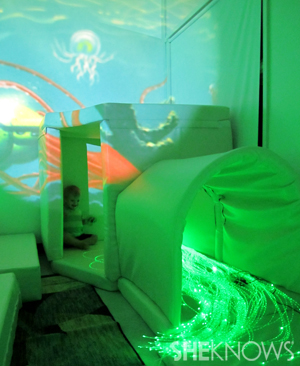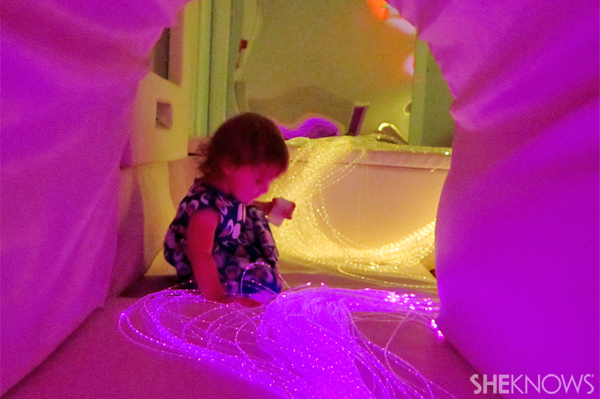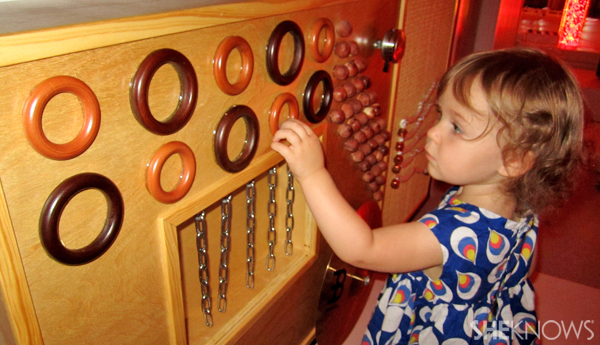How to create a multi-sensory experience room
UNLOCK SECRETS OF THE SENSES
Lennie Latham has worked with children with sensory issues for more than 15 years without seeing a state-of-the-art multi-sensory environment (MSE) room quite like the one she now manages — and that she hopes will become a model for parents, educators and caregivers nationwide.
Using an MSE room, therapists, teachers and parents can help assess a child's sensory issues, leading to often life-changing discoveries and effective new treatments. This article tours a state-of-the-art MSE room in Charlotte, North Carolina, and points out ways to incorporate its features into your own MSE room, whether you are a parent, educator or caregiver.
Who can benefit?
The Sensory Processing Disorder (SPD) Foundation reports at least one in 20 people in the general population may be affected by SPD. In children who are gifted and those with ADHD, autism and fragile X syndrome, the prevalence of SPD is much higher than in the general population.
Children with SPD may have trouble processing one or more senses, for example, the boisterous chatter on a playground may be overwhelming. Alternately, a child with SPD may lack the sensory input his body needs to motivate him to engage with others, prompting him to do something repetitively, like banging his head, to create the input his body seeks.
When Easter Seals UCP began its plans to build an MSE room at the Easter Seals UCP Irwin & Carol Belk Children's Center in Charlotte, North Carolina, the purpose was to provide a room that helped children with SPD find a balance between relaxation and activity within the framework of a safe, adapted environment designed to stimulate all five senses (i.e., sight, sound, touch, smell and taste).
"The idea is that the children experience different sensory input, engaging different parts of their brain in a safe environment," Latham explains.

Today, the 400-square-foot room in Charlotte is the only MSE room available to the public in the Charlotte area. Each child's experience is intended to be almost entirely self-directed, with a therapist accompanying the child and manipulating a light projector and music system as appropriate. Because the goal is to allow the child to steer his or her own course, speaking is minimal. It's all about letting the child explore independently.
Our family has visited the room twice for our 3-year-old son, Charlie, who has Down syndrome. The two visits were remarkably different, as Charlie began to explore and feel more comfortable with the new sensory experiences.
How-to tips to create an MSE space
While not every family can travel to Charlotte, North Carolina, to visit this unique MSE room, Latham and other experts offer tips for creating a similar experience either at home or in a school or caregiver environment.
Linda Messbauer has more than 30 years of experience with MSE rooms and was the first person to create a Snoezelen/MSE room in the United States, according to her website. She assists organizations, groups and individuals who wish to create and use multi-sensory environments to provide treatment and quality care to the people they serve.
"A multi-sensory environment is not a plug and play toy," Messbauer emphasizes. "Look for a qualified person who has actually been through at least two to three days of training — at least 16 hours working and learning in an actual MSE room — and has worked with children in an MSE for at least one year for assistance and questions before you buy materials."
Visual tour
At the entrance of the MSE room in Charlotte, a waiting room with two-way glass allows parents to observe the session comfortably without distracting the child by being in the room. Once inside, every corner of the room is dedicated to a sensory experience set against a canvas of spotless white leather mats and platforms.
Clockwise from the entry, bubble tubes sit on a raised white leather platform and stretch from platform to ceiling, changing color and announcing each new color as the child presses buttons. The corner is wrapped in floor-to-ceiling mirrors, so the tubes multiply visually.
Stepping down from the platform, the child can move to another platform of white leather, but this time it's a roiling water bed. Latham says most rooms use that space for a ball pit, but either material functions to address mobility issues.
Make sure the time you dedicate to a multi-sensory experience is calm and unhurried. Children may react differently over the course of multiple visits/uses, so be patient. During our first visit, Charlie touched the water bed, recoiled as it began to move and then wouldn’t go near it. During our second visit, he climbed all over it with a smile on his face.
Provide a "safe place"
In the next corner is a child's dream fort: An "igloo" made of foam mats wrapped in white leather. Latham explains that many children with sensory issues tend to seek out a “safe place,” which the igloo accommodates.
Charlie ignored the igloo entirely during our first visit and played inside for quite some time during our second visit.
Beside the igloo is an infinity mirror, which looks like an exaggerated shadowbox that stretches back into the wall and is lined with multi-colored light bulbs that change color as the child pushes buttons, sees the color change and hears the new color announced.
Incorporate projector, soft lighting
Experts emphasize the need for calming, gradual shifts in light and color, using all primary colors and avoiding jarring flashes. "You want the inside [environment] to match the outside [environment]," Latham explains, which means excluding fluorescent lights that don't offer gradation.
A projector sits atop a podium, providing visual sensory input via calming shapes and images in different, soft colors onto the wall or ceiling, leading the child to follow the colors or shapes from point to point (but again, this is gradual — no quick movements).
An octopus of fiber optics splayed across the mats offers both a visual and tactile experience, as the "wires" emit different colors.
Keep a routine
Latham emphasizes the need to adhere to a routine each time the child uses an MSE room. "The idea is to do it repetitively," she says. "If you start with the bubble tubes, then you always start with the bubble tubes." Keep each experience predictable while also introducing novel experiences.
Provide variety of tactile materials
Throughout the room in Charlotte, a variety of tactile opportunities let children touch and feel different materials. A simple bucket of sensory tools such as rubber balls and soft hair brushes is found in one corner, while a more intricate tactile board hangs from a wall, knee high for an adult, with differently shaped metal objects, beads and rope.
Pinterest offers a variety of sensory tool ideas to include in an MSE room. In addition, Linda Messbauer's website offers resources for materials and vendors and tips for creating your own MSE room.
Incorporate music
Every child entering an MSE room has different needs. Latham explains the importance of "matching them where they are." For example, for a highly active child whom a therapist wants to calm down, choose fast-paced music to begin the session, then gradually shift to calmer, slower tunes. The music should always be instrumental only — no lyrics or singing.
Alternately, if a child needs stimulation, start with low, calming music and then gradually increase the tempo.
Learn about "changing arousal to relax, re-energize and refocus" to best address a child's needs from an MSE room >>
Expertise available nationwide
Latham and Messbauer agree an MSE room is only as good as the expertise behind it and the supervision while a child experiences it. To that end, she offers design consultation services.
"I love what I do and am passionate about spreading the word about the need for ethics in the development of multi-sensory environments and the process involved in setting them up properly and having people formally trained," Messbauer says.
What results can you expect?
Messbauer says when using an MSE room effectively, parents can "expect to see changes in behavior, better sleeping patterns and changes in muscle tone." She advises that more frequent visits will prompt faster changes, but any amount of visits can help a child — it just may take a little longer if the visits are less frequent.
Want to create an MSE room?
Make sure you have a dedicated space and, if possible, the means to completely enclose it, including blacking out any windows. Some materials to consider for your MSE room include:
- Laser Galaxy Projector — note: Do not use the strobe features
- Laser Stars Indoor Light Show
- Lava lamps
- Constellation night light
- Light up eggs or SPOKA LED night lights
- Dimmer switch for a lamp
- Instrumental with different tempos, such as Jungle Jamz
- Sheer curtains to cover windows or mirrors that would reflect the light from any of the projectors in a startling way
- Sensory accessories: Toys with different textures, lights and sounds
- Weighted medicine balls (or other safe-weighted objects)
- Hoberman large expanding sphere toy
- Scents (first, learn what scents are pleasing and not distracting to the child)
- Portable mirror and/or distorted mirror
- Bean bag chairs
For a full catalog of multi-sensory products, visit Sens-Aura.
Leveraging an MSE room is best done in small doses. Messbauer recommends introducing the experience after school, before homework or before bedtime.
"Everyone is unique and deserves the right to the best we can give them — to help them... learn to help themselves," Messbauer shares. "All they need is the opportunity and a good coach."
Work with experts
Messbauer and Latham advise leveraging resources that can ensure the room's design is appropriate for the patients who intend to use it.
"Consider your budget and the space you have to work with," Latham advises parents, caregivers and educators. "Is it a dedicated space that won't be used for other purposes, or are you fitting it within space such as a playroom or bedroom?
"From there, create a safe, comfortable environment for your child to explore while experiencing input from all his or her different senses."
The American Association of Multi-Sensory Environments (AAMSE) offers certification, training and workshops to learn how to best treat SPD with an MSE room. AAMSE also offers links to other MSE-related resources.
Messbauer's site includes links to vendors and MSE equipment, as well as other organizations that can provide information and support. She also recommends the book, The Science of You: The Factors That Shape Your Personality.
What not to do
It's easy to get excited about creating an MSE space, but Latham and Messbauer caution against two primary mistakes:
- If you're a parent creating an MSE room by yourself, don't overdo it (either by overstimulation or over-use of the room).
- Don't spend a lot of money trying to create an MSE without understanding what to do with it. Resources such as AAMSE and Messbauer are available to assist.
Image credit: Maureen Wallace


